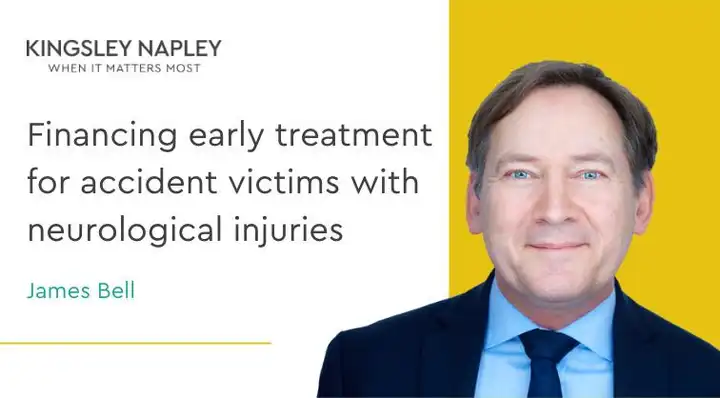
4 minute read
Financing early treatment for accident victims with neurological injuries
Although the Rehabilitation Code is a vital tool for lawyers fighting for neurologically injured clients, since it provides a key avenue for obtaining early and potentially life altering interventions, nevertheless, much more needs to be done to ensure that it is an effective option for all those who could benefit. The Code is a voluntary initiative for personal injury legal claims, first published in 2007 and most recently updated in 2015. Its purpose is to help claimants get treatment they need to enable the best and speediest medical, social and psychological recovery. Accordingly, the Code is of particular significance to those with serious neurological injuries, as these often benefit considerably from early intervention. With long waiting lists and limitations on innovative treatments offered by the NHS, private rehabilitation services can be hugely positive for such claimants. The purpose of the Code is to assist both the claimant and defendant. The claimant can access rehabilitation more swiftly, often providing a better chance of a good recovery, and the defendant may, as a result, pay less in compensation. Despite this, in my experience with the Code in action, outcomes can at times be mixed.
The Code requires that claimant and defendant lawyers collaborate to address the injured party’s needs from first notification of a legal claim. In the case of a serious neurological injury, it sets out that any assessment of needs must be by a rehabilitation professional or case manager, who should carry out an immediate needs assessment (INA) and produce a full report detailing recommendations. This will usually be paid for by the defendant, who must then consider whether they will fund any or all of those recommendations.
Advertisement
The Code makes clear that any private care should be arranged, wherever possible, in liaison with a claimant’s current medical team to avoid causing any problems with existing treatment.
The Code establishes that a claimant’s need for rehabilitation should be addressed as a priority, whether liability in the claim has been agreed or not. In the normal course, where there has been an admission of liability, the Courts can order an interim payment of damages. However, this process is not always practicable, quick or indeed the most cost-effective approach and using the Code can allow specialist treatment to be commenced more speedily. Yet, where liability has not been conceded, the situation becomes much more problematic.
The Code clearly states that, irrespective of there being no agreement on liability, the health and economic benefits of early rehabilitation, where severe injuries have been suffered, can be especially strong.
Nevertheless, defendants inevitably have concerns about paying for rehabilitation in this scenario since, under the Code, if a claimant eventually loses their case they would not be bound to repay any funding. For neurological injuries, rehabilitation interventions are often extremely expensive. They may include a period of in-patient care and input from disciplines including occupational therapy, speech and language therapy, physiotherapy and psychological therapy.
Nonetheless, where a defendant’s case is by no means strong and no admission has been made, it can be short sighted to ignore the Code. For, in my experience, where a pragmatic approach is taken in the absence of an agreement on liability, this almost always leads to a positive outcome for both parties, with a swifter settlement and significant costs savings as a result.
My team at Kingsley Napley are experts in obtaining the best rehabilitation outcomes for our neurologically injured clients and we seek to use the Code whenever possible generally with excellent outcomes. However, there are arguably insufficient incentives for defendants in all cases to engage. The Code is linked to the Pre-Action Protocols for both Personal Injury Claims and Clinical Disputes which set out certain principles with which parties to a legal claim are expected to comply before formal court proceedings are issued.

The Protocols are not legally binding but non-compliance with aspects of them can lead to financial consequences, for example, having to pay more in legal costs to the other party. Despite this, a recent judgement (Andrew Evans v R&G Allgemeine Verischerung AG [2022]) concluded that a failure to comply with the Rehabilitation Code did not mean that the defendant should face penalising cost consequences (indemnity costs). While I understand the lines are difficult to draw here, I hope that this issue will be revisited and re considered by the courts as soon possible. For cases of medical negligence, it is my experience that NHS Resolution, the body dealing with clinical claims on behalf of the NHS, and indeed many other indemnifiers in this field, do not fund early rehabilitation in the absence of liability being admitted. While the Code itself references ‘personal injury claims’, the Protocol for clinical cases refers to the Code and is clear that early rehabilitation should be considered. Nonetheless, as matters stand for victims of medical accidents, access to the Code and to early rehabilitation is very underutilised. I have had significant success with the Code in personal injury claims and it is my view that the Code needs to be made mandatory in medical negligence cases. Clarity is required on the scope of the Code to achieve this.
I am also aware that there are suggested abuses of process where INA reports have been obtained and then no agreement to fund any recommendations has been forthcoming or have been very delayed. It also appears that on occasions the INA report has been used to help the defendant value the claim or to inform a premature offer of settlement rather than to genuinely assist early rehabilitation. There is no doubt in my mind that the Code should be championed wherever possible and defendants reminded at the outset of claims of their obligation to consider this empathetic route which can be so life enhancing for those needing to fight for compensation.










